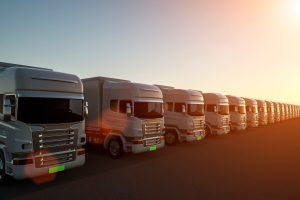By Lauren Navarro and Tom Cackette
The Superior Clear Fleets rule is a purchase order requirement for medium and heavy-duty fleets to undertake an growing proportion of zero-emission vehicles. It’ll complement the beforehand adopted Superior Clear Vans regulation requiring producers to promote ZEV vehicles. Collectively the 2 laws are crucial technique of reaching Gov. Newsom’s govt order requiring 100% of industrial quality truck fleets within the state to be zero-emission, wherever possible, by 2045.
We want these guidelines as a result of heavy-duty vehicles at present account for 26% of all smog-forming nitrogen oxide emissions in California and a few third of cellular diesel high quality particulate matter emissions. They’re additionally main producers of local weather change emissions (about 8%) at a time when our planet can not take any extra local weather change. Heavy-duty truck emissions will not be evenly distributed — they are typically concentrated in underserved communities, which are sometimes situated close to warehouses, distribution facilities, ports and main roadways.
Changing these vehicles with ZEV choices will go a protracted method to decreasing these air pollution and enhancing public well being. As well as, they may get monetary savings; the California Air Assets Board’s evaluation of its proposed ACF rule estimates a internet profit financial savings of $47 billion between 2024 and 2050, which incorporates $20 billion in financial savings to fleet operators. Adopting Various 2, as beneficial by many environmentalists, would end in even stronger advantages.
The Superior Clear Fleets rule defined Click on To Tweet
Construction of the regulation
The proposed ACF rule dietary supplements the gross sales element of the prevailing ACT regulation, beforehand very open-ended, by requiring new vehicles bought in California to be 100% ZEV beginning in 2040.
The proposed rule consists of three totally different buy necessities for fleet operators: 1) for personal fleets with 50 or extra vehicles (together with federal fleets and companies with gross annual income of $50 million or extra no matter fleet dimension); 2) for drayage vehicles working from seaports or railyards and; 3) for state and native authorities public fleets.
An necessary nuance is {that a} state legislation, SB 1, prevents the California Air Assets Board from requiring an current diesel truck be faraway from a fleet till it’s 13 years outdated and has collected over 800K miles, or is over 18 years outdated. This provision delays how rapidly the complete transition to ZEV vehicles can occur.
- Non-public “excessive precedence” fleets
- Begins in January 2024 and applies to heavy-duty vehicles and light-duty vehicles utilized in package deal supply that function in California.
- Two compliance choices:
- Possibility 1: All new autos added to a fleet have to be ZEV. Older fossil-fuel autos are faraway from fleet when SB 1 statutory helpful life is reached.
- Possibility 2: Fleet composition (% ZEVs within the fleet) within the following desk have to be met even when it means retiring a fossil-fuel car in any other case exempted by SB 1 (i.e., over 13 years outdated and > 800K miles, or over 18 years outdated). In contrast to Possibility 1, this feature permits continued buy of fossil gasoline autos so long as the fleet composition goal is met earlier than the 12 months 100% ZEVs are required.
ZE Fleet Composition Requirement – Possibility 2
Drayage vehicles
- Applies to vehicles that carry cargo from California seaports and intermodal railyards.
- Widespread possession and management necessities apply so shippers turn out to be accountable for compliance and particular person drayage operators turn out to be “a part of the shipper or dealer’s fleet.”
- Vans have to be registered in CARB’s on-line system to have entry to the ports, then:
- Starting in 2024, any new registrants have to be ZEVs vehicles.
- Non-ZEV vehicles registered previous to 2024 (legacy autos) can proceed to function in the event that they transfer cargo on the port at the very least as soon as every year.
- Nonetheless, legacy vehicles are faraway from the registry, starting in 2025 if the engine within the truck is over 13 years outdated and has collected greater than 800,000 miles, or is over 18 years outdated.
- Starting in January 2035, all drayage vehicles have to be ZEV.
- State and native authorities fleets
- Applies to authorities fleets of any dimension.
- Begins January 2024.
- Requires that an growing proportion of latest autos bought be ZEV:
- 2024: 50% of latest autos bought have to be ZEV.
- 2027: 100% of latest autos bought have to be ZEV.
- Delayed begin to 2027 for low inhabitants (rural) companies.
What’s subsequent?
EDF and different organizations are proposing three adjustments to the CARB employees proposal that may speed up the transition to ZEVs and improve public well being advantages of the regulation.
First, the 100% ZEV gross sales requirement needs to be moved as much as 2036 as an alternative of 2040. A new report reveals this transformation would generate $2.7 billion in further well being care financial savings by 2050, reduce a further 24 million metric tons of local weather air pollution, and put 133,000 ZEV vehicles on the highway in 2050 (comprising 78% of all vehicles). In 2035, the common ZEV truck will value virtually $50,000 much less to function over its lifetime than a combustion engine truck.
Second, the 50 or larger fleet dimension flooring for the in personal fleet necessities to use needs to be decreased to 10 autos for Class 7 and eight vehicles (these are the massive tractors that pull separate trailers). These tractors account for less than 12% of MHD vehicles however emit half of the NOx from all MHD vehicles. This variation would lower NOx and PM2.5 emissions by a further 16% in comparison with the CARB employees proposal.
Third, within the fleet ZEV composition schedule for personal fleets (See Desk above) the Class 8 sleeper cabs needs to be moved up three years to be in keeping with the day cabs (row 2 of the desk).
CARB has analyzed the mixed impact of our three beneficial adjustments and presents the outcomes as Various 2 in its employees report, which is obtainable for public remark. The evaluation signifies Various 2 ends in 59% larger well being advantages, 55 to 60% further NOx, PM2.5 and GHG emission reductions, and even a small improve within the internet financial savings to fleet operators. Adopting Various 2 of the ACF rule somewhat than the employees proposal presents a essential alternative to extra quickly clear up the air in California and takes a stronger step in the direction of assembly the Governor’s local weather objectives, whereas lowering the price of operation for fleet house owners. Our leaders should finalize a stronger rule.
CARB is at present accepting written public feedback on the ACF rule till October 17, and can maintain a public listening to on October 27 in Sacramento with a possibility for in-person or distant oral feedback.







0 Comments